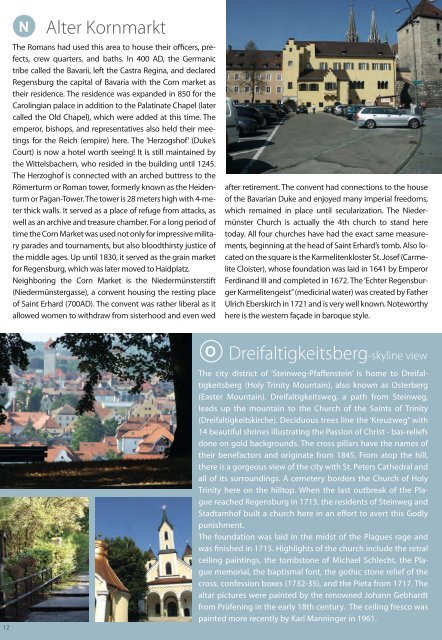Download - Regensburger Touristen Guide
Download - Regensburger Touristen Guide
Download - Regensburger Touristen Guide
You also want an ePaper? Increase the reach of your titles
YUMPU automatically turns print PDFs into web optimized ePapers that Google loves.
12<br />
N<br />
Alter Kornmarkt<br />
The Romans had used this area to house their officers, prefects,<br />
crew quarters, and baths. In 400 AD, the Germanic<br />
tribe called the Bavarii, left the Castra Regina, and declared<br />
Regensburg the capital of Bavaria with the Corn market as<br />
their residence. The residence was expanded in 850 for the<br />
Carolingian palace in addition to the Palatinate Chapel (later<br />
called the Old Chapel), which were added at this time. The<br />
emperor, bishops, and representatives also held their meetings<br />
for the Reich (empire) here. The ‘Herzogshof’ (Duke’s<br />
Court) is now a hotel worth seeing! It is still maintained by<br />
the Wittelsbachern, who resided in the building until 1245.<br />
The Herzoghof is connected with an arched buttress to the<br />
Römerturm or Roman tower, formerly known as the Heidenturm<br />
or Pagan-Tower. The tower is 28 meters high with 4-meter<br />
thick walls. It served as a place of refuge from attacks, as<br />
well as an archive and treasure chamber. For a long period of<br />
time the Corn Market was used not only for impressive military<br />
parades and tournaments, but also bloodthirsty justice of<br />
the middle ages. Up until 1830, it served as the grain market<br />
for Regensburg, which was later moved to Haidplatz.<br />
Neighboring the Corn Market is the Niedermünsterstift<br />
(Niedermünstergasse), a convent housing the resting place<br />
of Saint Erhard (700AD). The convent was rather liberal as it<br />
allowed women to withdraw from sisterhood and even wed<br />
O<br />
after retirement. The convent had connections to the house<br />
of the Bavarian Duke and enjoyed many imperial freedoms,<br />
which remained in place until secularization. The Niedermünster<br />
Church is actually the 4th church to stand here<br />
today. All four churches have had the exact same measurements,<br />
beginning at the head of Saint Erhard’s tomb. Also located<br />
on the square is the Karmelitenkloster St. Josef (Carmelite<br />
Cloister), whose foundation was laid in 1641 by Emperor<br />
Ferdinand III and completed in 1672. The ‘Echter <strong>Regensburger</strong><br />
Karmelitengeist” (medicinal water) was created by Father<br />
Ulrich Eberskirch in 1721 and is very well known. Noteworthy<br />
here is the western façade in baroque style.<br />
Dreifaltigkeitsberg-skyline view<br />
The city district of ‘Steinweg-Pfaffenstein’ is home to Dreifaltigkeitsberg<br />
(Holy Trinity Mountain), also known as Osterberg<br />
(Easter Mountain). Dreifaltigkeitsweg, a path from Steinweg,<br />
leads up the mountain to the Church of the Saints of Trinity<br />
(Dreifaltigkeitskirche). Deciduous trees line the ‘Kreuzweg” with<br />
14 beautiful shrines illustrating the Passion of Christ - bas-reliefs<br />
done on gold backgrounds. The cross pillars have the names of<br />
their benefactors and originate from 1845. From atop the hill,<br />
there is a gorgeous view of the city with St. Peters Cathedral and<br />
all of its surroundings. A cemetery borders the Church of Holy<br />
Trinity here on the hilltop. When the last outbreak of the Plague<br />
reached Regensburg in 1713, the residents of Steinweg and<br />
Stadtamhof built a church here in an effort to avert this Godly<br />
punishment.<br />
The foundation was laid in the midst of the Plagues rage and<br />
was finished in 1715. Highlights of the church include the retral<br />
ceiling paintings, the tombstone of Michael Schlecht, the Plague<br />
memorial, the baptismal font, the gothic stone relief of the<br />
cross, confession boxes (1732-35), and the Pieta from 1717. The<br />
altar pictures were painted by the renowned Johann Gebhardt<br />
from Prüfening in the early 18th century. The ceiling fresco was<br />
painted more recently by Karl Manninger in 1961.


